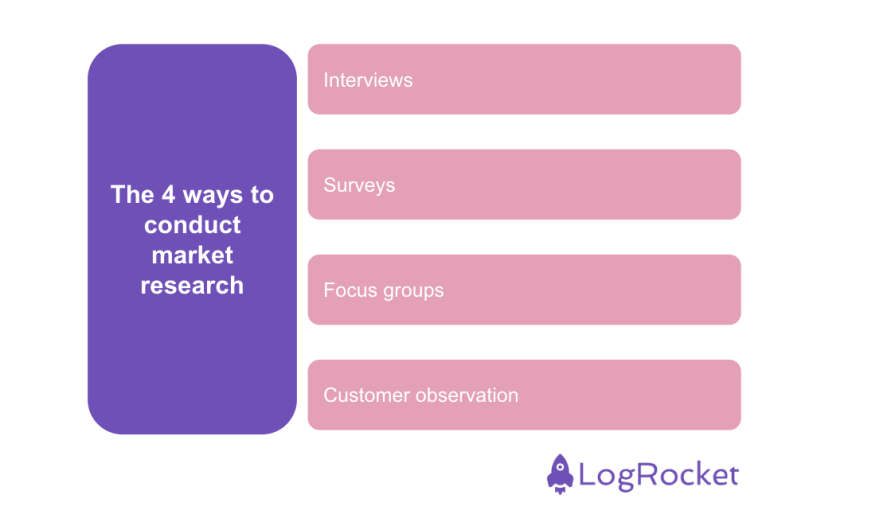Assumptions only get you so far when it comes to developing a product and growing your business. Market research can provide you with crucial insights into what your audience and customers need from you. Armed with this data, you can differentiate your product from your competitors and work towards winning your market.

In this article, you will learn what market research is, the four approaches to it, and the steps you need to take to make more informed product decisions.
Market research is the process of gathering information about potential and current customers and your target audience. The data can reveal the viability of a new product idea based on customer needs and wants. Market research is an essential part of developing products and services that are desirable to consumers.
Market research is also used to:
Market research is a critical part of research and development (R&D). Bad market research can lead to making decisions based on assumptions, emotional reasoning, and other guesswork. Ultimately, market research is the only way to make informed decisions about what you need to develop for your product.
Market research falls into two categories: Primary and secondary. Primary research is gathered by the company, while secondary research comes from outside sources. Both of these options provide valuable information on your target audience.
For this article, let’s focus on primary research. There are four methods you can use to collect primary data for your market research:

Interviews are face-to-face meetings with an individual. This can be one of the most insightful market research methods since there is no interaction with outside influences that may affect the opinion of the interviewee. It allows an interviewer to ask deeper questions, while also providing a chance to observe body language.
Surveys are a useful method for collecting data quickly. Surveys can appear on the company website or app and ask questions directly to consumers. You can have multiple choice, scales, or yes and no questions to gain several types of data points. It’s also a relatively easy and cost-effective method to deploy.
Focus groups are a tricky method of market research. Participants of a focus group make up the company’s target audience. When done well, they can provide insights into a group’s perceptions of a company’s products, advertising, or competitors. However, it requires a trained moderator to ensure participation from all members of the focus group and prevent a minority party from leading the conversation.
Customer observation is a powerful way to gain an understanding of how customers are interacting with your product. You can learn a lot from how they react to the product, what obstacles they encounter, and what questions they have while using it.
While you can observe in person, you could also use tools like a heat map to conduct customer observation. Alternatively, you can also ask participants to test out a competitor’s product to see how they engage with the product.
While interviews, surveys, focus groups, and customer observations are the 4 most common types of market research, companies can also use these other methods to do their research, including:
Market research can seem like a large and daunting project. To help you break it down into manageable tasks, here is a basic step-by-step guide to conducting market research.
Begin by determining what you want to learn from the market research. You’ll get the best results when you can clearly define the problem or question. Once you have defined your market research goal, then you can choose which market research method would work best.
Let’s explore this example throughout the guide: Your company wants to know if your product is satisfying the needs of your current customers
If you don’t know who your customers are, then you should create buyer personas before you move further along in the market research process.
The next step is to identify which buyer persona or persona groups have the information you need to answer your market research goal. Choosing the right personas to participate is necessary to avoid wasting resources.
Example: You want to collect data from active users. You may also receive valuable insights from users who use your product infrequently or didn’t purchase the product
At this stage, you can determine which research methods are best for collecting data. You’ll also form the right questions to ask. All questions should be open-ended to give participants the chance to share their opinions freely without feeling judged or influenced by the moderator.
Preparing questions in advance helps you stay focused on the market research. However, if you’re conducting interviews or focus groups, then it’s important to stay flexible and ask deeper questions based on how the conversation is going. You should consider these core principles while interviewing an individual or a group:
Once the methods and questions are determined, you can start to collect your data.
Example: To collect data from current users, a pop-up survey will appear when a user logs into their account. It has a scale of 1-10 and asks “How satisfied are you with our product?” Once a user answers, they have the option to provide a short answer on what the product could do better
When analyzing data, you should look for themes or patterns in responses. You can also utilize data visualization tools to help detect any trends. Once you have analyzed your data, you can create a report based on the findings. It may include items like:
Most importantly, your report should include an action plan on how to resolve issues discovered in the market research. This could involve creating more useful user guides, creating or modifying a new feature, or a more efficient onboarding process.
Example: Results from the survey showed that unhappy customers frequently didn’t know where to go to get help on using the product. An action plan is created to develop how-to tutorials
The market research report is presented to executives, and they need to decide on the best way to move forward. It may involve approving the action plan or finding alternative solutions. The good news is that they are going to make a data-based decision because they have accurate information on their customers and target audience.
Once a plan is approved, product managers or other departments can begin working on implementing changes.
Example: Executives approve an action plan to develop how-to tutorials. A knowledge base is created for users filled with written and video tutorials on how to use product features
Market research is not a one-time-only project. It should be continually conducted to provide insights into your product, industry, trends, and other factors that could affect your business. The market research process will help you maintain a competitive advantage while ensuring every iteration of your product is meeting the needs of your target audience.
Market research is more than something you do to confirm if there is customer interest in your product idea. It’s there to support you for nearly every important pillar of your business, including product development, marketing, and business growth. Continuously conducting market research will help your company stay in touch with your customers and emerging trends.
Market research can be as simple as a one-question survey to 30-minute interviews with your target market. Regardless of the method, you stand to glean valuable insights that you can turn into a data-informed action plan.
Featured image source: IconScout

LogRocket identifies friction points in the user experience so you can make informed decisions about product and design changes that must happen to hit your goals.
With LogRocket, you can understand the scope of the issues affecting your product and prioritize the changes that need to be made. LogRocket simplifies workflows by allowing Engineering, Product, UX, and Design teams to work from the same data as you, eliminating any confusion about what needs to be done.
Get your teams on the same page — try LogRocket today.

A practical framework for PMs to use AI in ideation without sacrificing judgment, strategy, or decision quality.

A practical five minute revenue estimation method to help product managers compare ideas, drop low impact features, and prioritize smarter.

A practical guide for PMs who want to stop being bottlenecks, delegate smarter, and lead teams effectively with a clear ownership framework.

Stop letting unreliable data block features. Treat data as inventory to track quality, ownership, and ship with confidence.